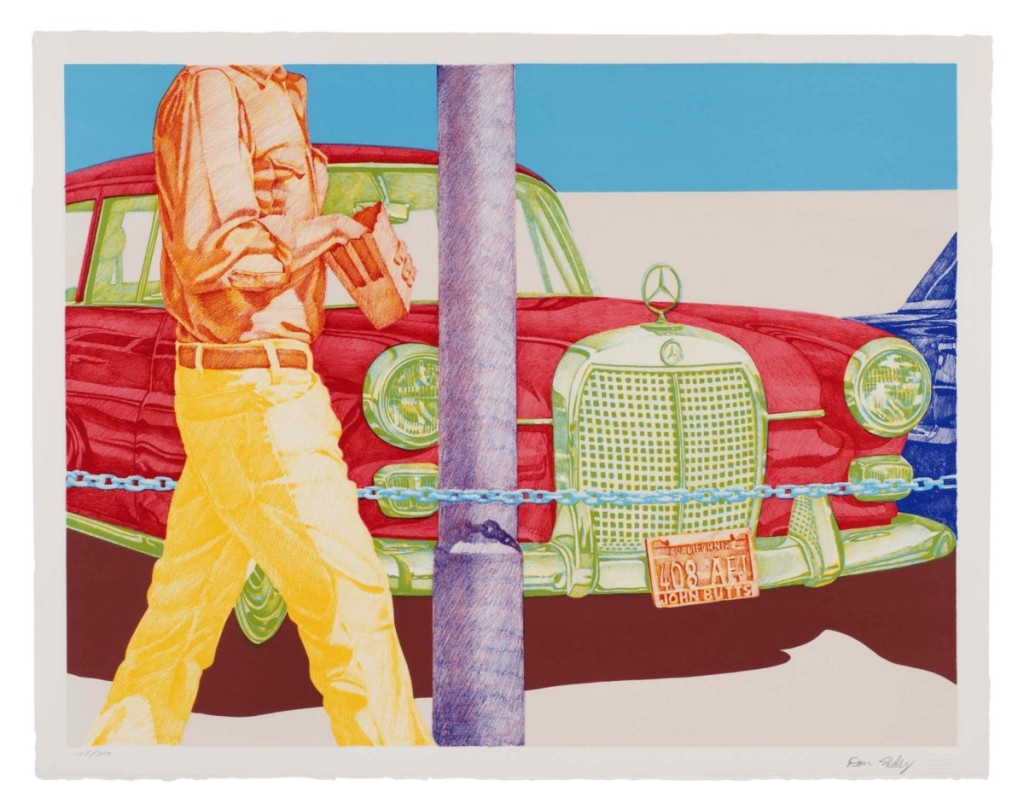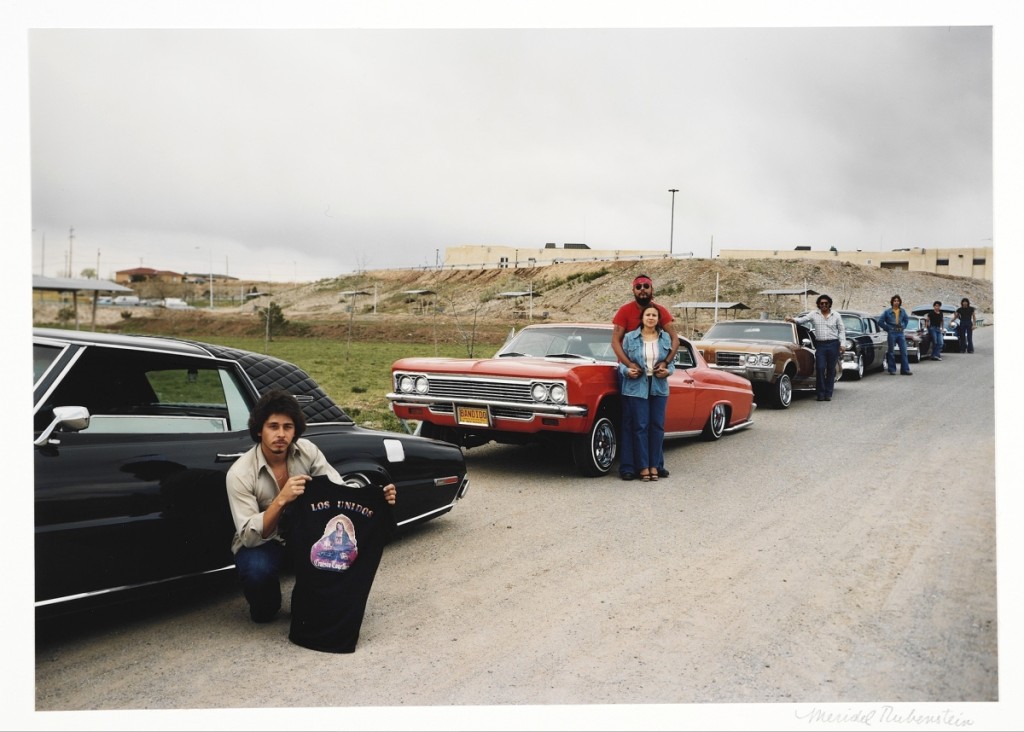
“Red Mercedes” by Don Eddy (b 1944), 1972. Color lithograph, 24-1/8 by 30-11/16 inches. Toledo Museum of Art, Frederick B. and Kate L. Shoemaker Fund, ©Don Eddy. Image Credit: Christopher Ridgway.
By Karla Klein Albertson
TOLEDO, OHIO – Car shows are common, but “Life is a Highway: Art and American Car Culture” – newly opened at the Toledo Museum of Art – is a rare show about how artists have viewed the automobile from an aesthetic perspective. If your map of the United States is composed of memorable family car trips, if you remember the make and model of that vehicle where you first got kissed, if you can sing all the verses to “Little Deuce Coupe,” Ohio might be your summer exhibition destination – time to hit the road.
On view through September 15th, the exhibition brings together a selection of extraordinarily diverse paintings, prints, photographs and sculptural works that illustrate the automobile’s emotional hold over the Twentieth Century psyche. Whether you were a moonshiner or a devotee of classic British sports cars, life in that hundred-year span involved moving vehicles. While the future of personal locomotion now presents a minefield of problems and possible solutions, owning a car in the 1900s was pure exhilaration. Cars symbolized freedom, expressed rebellion and provided the only place where you could get away from your folks.
Museums are increasingly reaching out to fresh audiences with exhibitions that bring in both traditional and exceptional visitors. This fascinating show will not travel, but all the assembled material and insights have fortunately been published in an accompanying catalog. Organizing the show and volume came naturally to Robin Reisenfeld, PhD, the museum’s curator of works on paper. In a recent conversation with Antiques and The Arts Weekly, she explained, “When I came to Toledo a few years ago, my arrival coincided with the Detroit Auto Show, and it was at that time that I was struck by the unique relationship that the Midwest has with the automobile. That was the initial observation that got me thinking about this topic. That was something I started to explore, and it really blossomed.”
“There was an embarrassment of riches. First, I looked at our holdings, and we had quite a few really great works, but I knew we needed some loans. As I began doing more research, one thing would lead to another. I was impressed by the amount of material that was available, so then I started narrowing it down and editing it. The exhibition celebrates the richness and diversity of imagery inspired by automobiles and related motifs. It brings together over 150 works, including sculpture and environmental art, photography, prints and drawings. The exhibition looks at how the automobile has impacted our life and the American landscape. So, it’s really about how the automobile has defined us and reshaped us throughout the Twentieth Century.”
Reisenfeld encountered some surprises as she realized “How much is out there, how entwined the automobile is with our lives and how much influence it has. Every one of us, even if we’re not a car buff, that vehicle shapes our daily activities. The automobile has defined our society. There’s a part of the exhibition that looks at how cars have been used as a means of self-expression and status and identity. Cars played a part in the development of youth culture after World War II; it became a personal space outside of the home where you could engage in romantic activities without being overseen by your parents.”
When installing the works, she noted, “It unfolds chronologically and thematically. Initially, the auto was celebrated as a symbol of technological progress. Subsequently, with the onset of the Great Depression, it was used in a less positive fashion to depict the hardships endured by the workers. After World War II, automobiles played a key role in the economic boom – it became a symbol of middle-class prosperity. In that section, we view exhibits on the family road trip, the appeal of driving, why it’s such a popular activity, the emergence of roadside commerce and culture.”
“Finally, we view the legacy of the car toward the latter part of the Twentieth Century – how it has impacted our environment and the landscape, played a key role in the development of our national highway system and reshaped how we go about our daily lives. Once, there was an infatuation with the automobile; now, we consider it a mixed bag, and we’re more critical. Another reason for doing this exhibition now is that the automobile is at a pivotal point. I hope people will come away with a better understanding of how the automobile has impacted society and a greater appreciation for the artists who have explored this subject.”
When asked to pick out several outstanding examples, the curator responded, “One of my personal favorites is Martin Lewis (1881-1962), ‘Which Way?’ from 1932. As a tour-de-force aquatint that portrays a night motorist pausing at a snowy highway junction along a rural road, it was an unexpected discovery for me. Though Martin Lewis is typically remembered for his cityscapes, he frequently introduced the automobile motif into his compositions – here to present the driver’s dilemma as a metaphor for the nation’s doubtful mood and the questioning of its future direction as it struggled through the Great Depression.”
“Alternatively, a painting by Charles Sheeler (1883-1965) titled ‘Classic Landscape’ (1931) and ‘Criss-Crossed Conveyors,’ his 1927 photograph of Henry Ford’s immense factory complex at River Rouge, are also extremely compelling works that the viewer will find in ‘The Emergence of Car Culture.’ In this section, which explores early car culture’s ties to the Midwest, Sheeler focuses upon the factory buildings’ monumental grandeur. With their tall smokestacks and columnar silos reaching to the sky, they convey the power and beauty of the technological and engineering advances of the period.”
As might be expected, photographs play an important role in the recorded history of automobiles. The catalog cover image is a color print by Helen Levitt (1913-2009) called “New York City (Spider Girl),” a 1980 shot of a woman in the classic what’s-happening position as she bends down to peer under her car’s rear end. Although at times car culture has seemed soaked with testosterone, there is a strong contingent of woman artists with works in this exhibition. For example, the three photographs in the show by Santa Fe-based artist Meridel Rubenstein (b 1948) are taken from her 1980 book The Lowriders: Portraits from New Mexico. The intimate relationship of wheels to members of both genders is discussed further by New York art writer and cultural critic Eleanor Heartney in her catalog chapter “Automobile Mon Amour.”

“Sammy Martinez and Los Unidos” by Meridel Rubenstein (b 1948), from The Lowriders: Portraits from New Mexico, 1980. Ektacolor 74 print, 14 by 17 inches. Purchased with the Madeleine H. Russell, class of 1937, Fund, Smith College Museum of Art, Northampton, Mass. ©Meridel Rubenstein.
But will there be any real cars in this show about auto art? Mike Deetsch, Toledo’s director of education and engagement, enjoyed putting together a strong calendar of special events in connection with this exhibition. There will be four drive-up Car Shows on the TMA grounds, where visitors can view the assembled cars and chat with owners. Deetsch explained, “We’re going to be closing a section of Monroe Street down four times this summer to have car shows on the street. For example, in July, we’re going to be hosting a Block Party featuring Jeeps. You may be aware of the long history of the Jeep in Toledo – we are the exclusive manufacturer of the Jeep Wrangler.”
“August will be American Classic Cars – ’57 Chevys, muscle cars from the 60s. Then, in September, on the closing day of the exhibition, we’ll be hosting Art & Modified Cars – low riders, decorated cars. So, each one of these four shows not only will have their own style of cars, we will have live music, food trucks, children’s activities. They will be mini-festivals throughout the summer with the anchor being the cars themselves. This will be an opportunity for us to draw audiences that don’t often have contact with one another, museumgoers and car show people. Through the car shows, the summer camps and our family space, we should be able to engage inter-generational audiences – kids coming with their parents and grandparents.”
Another crowd pleaser, the museum will offer a series of 16 films entitled “Find One in Every Car: On the Road in American Movies.” The schedule leads off with Bullitt (1968) and its memorable muscle car chase through the streets of San Francisco, includes American Graffiti (1973), Thelma and Louise (1991) and The Fast and the Furious (2001), then ends with Green Book (2018), which won the Oscar for Best Picture this year.
The Toledo Museum of Art is located at 2445 Monroe Street at Scottwood Avenue, just off I-75. Call 800-644-6862 or visit www.toledomuseum.org to learn more.



.jpg)














